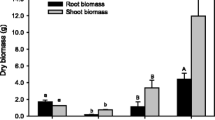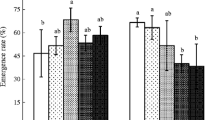Abstract
Remedial guidelines for petroleum hydrocarbons (PHCs) in soil aid in the mitigation of risks to human health and the environmental. However, some remediation guidelines may overestimate the potential for adverse effects to native plant species, contributing to unnecessary remedial efforts in attempts to meet the guidelines. At sites where PHC-contaminated soils undergo weathering, some PHCs may persist but with decreased bioavailability to organisms. In this study, the toxicity of both coarse and fine-grained subarctic soils, contaminated with weathered PHCs were assessed using five native plant species (Picea mariana, Achillea millefolium, Alnus viridis, Elymus trachycaulus and Salix bebbiana). Soil toxicity tests were conducted in a growth chamber with parameters set to simulate the site’s subarctic climate conditions. Reference toxicant tests using boric acid were conducted to provide confidence in the interpretation of the results for the PHC-contaminated soils, and also provide new information on the sensitivities of the four boreal species to boric acid. All plants exhibited reduced growth and germination rates as boric acid concentrations increased. Despite exceeding the Canada-wide standard guidelines for Fraction 3 PHCs, field-collected contaminated soils had no significant negative impacts on the growth (i.e., length, dry weight and emergence) of any of the plant species tested.





Similar content being viewed by others
Data availability
Data recorded during this study are available from the corresponding author upon reasonable request.
References
Alberto Orocio-Carrillo J, del Carmen Rivera-Cruz M, Manuel Aranda-Ibañez E et al. (2019) Hormesis under oil-induced stress in Leersia hexandra Sw. used as phytoremediator in clay soils of the Mexican humid tropic. Ecotoxicology 28:1063–1074. https://doi.org/10.1007/s10646-019-02106-1
Alexander M (2000) Aging, bioavailability, and overestimation of risk from environmental pollutants. Environ Sci Technol 34:4259–4265. https://doi.org/10.1021/es001069
Amorim MJB, Natal-Da-Luz T, Sousa JP et al. (2012) Boric acid as reference substance: pros, cons and standardization. Ecotoxicology 21:919–924. https://doi.org/10.1007/s10646-011-0832-9
Amtmann A, Blatt MR (2009) Regulation of macronutrient transport. New Phytol 181:35–52. https://doi.org/10.1111/j.1469-8137.2008.02666.x
Angell RA, Kullman S, Shrive E et al. (2012) Direct soil contact values for ecological receptors exposed to weathered petroleum hydrocarbon (PHC) fraction 2. Environ Toxicol Chem 31:2536–2544. https://doi.org/10.1002/etc.1974
Brunner I, Sperisen C (2013) Aluminum exclusion and aluminum tolerance in woody plants. Front Plant Sci 4:1–12. https://doi.org/10.3389/fpls.2013.00172
Burger J, Gochfeld M, Bunn A et al. (2016) Functional remediation components: a conceptual method of evaluating the effects of remediation on risks to ecological receptors. J Toxicol Environ Heal Part A Curr Issues 79:957–968. https://doi.org/10.1080/15287394.2016.1201026
Canadian Council Ministers of the Environment (2014) Canada-wide standards for petroleum hydrocarbons (PHC) in soil. 2014 Progress Report. Canadian Council of Ministers of the Environment, Winnipeg, Manitoba, Canada
Carvalho JM, Ramos SJ, Furtini Neto AE et al. (2018) Influence of nutrient management on growth and nutrient use efficiency of two plant species for mineland revegetation. Restor Ecol 26:303–310. https://doi.org/10.1111/rec.12572
Castro-Mancilla YV, de la Rosa-Manzano E, Castro-Nava S, Martínez-Avalos JG (2019) Physiological responses of Quercus oleoides (Schltdl & Cham) to soils contaminated by diesel. Plant Prod Sci 22:519–529. https://doi.org/10.1080/1343943X.2019.1605833
CCME (2001) Reference method for the Canada-wide standard for petroleum hydrocarbons in soil—tier 1 method. Canadian Council of Ministers of the Environment, Winnipeg, Manitoba, Canada
Cedergreen N, Nørhave NJ, Nielsen K et al. (2013) Low temperatures enhance the toxicity of copper and cadmium to Enchytraeus crypticus through different mechanisms. Environ Toxicol Chem 32:2274–2283. https://doi.org/10.1002/etc.2274
Chen YA, Grace Liu PW, Whang LM et al. (2020) Effect of soil organic matter on petroleum hydrocarbon degradation in diesel/fuel oil-contaminated soil. J Biosci Bioeng 129:603–612. https://doi.org/10.1016/j.jbiosc.2019.12.001
Colmenero-Flores JM, Franco-Navarro JD, Cubero-Font P et al. (2019) Chloride as a beneficial macronutrient in higher plants: new roles and regulation. Int J Mol Sci 20:1–32. https://doi.org/10.3390/ijms20194686
Das N, Chandran P (2011) Microbial degradation of petroleum hydrocarbon contaminants: an overview. Biotechnol Res Int 2011:1–13. https://doi.org/10.4061/2011/941810
Di Toro DM, McGrath JA, Stubblefield WA (2007) Predicting the toxicity of neat and weathered crude oil: toxic potential and the toxicity of saturated mixtures. Environ Toxicol Chem 26:24–36. https://doi.org/10.1897/06174R.1
Environment Canada (2007) Biological test method: test for measuring emergence and growth of terrestrial plants exposed to contaminants in soil. Environment Canada, Ottawa, Ontario
Environment Canada (2013) Biological test method: test for growth in contaminated soil using terrestrial plants native to the boreal region. Environment Canada, Ottawa
Eze MO, George SC, Hose GC (2021) Dose-response analysis of diesel fuel phytotoxicity on selected plant species. Chemosphere 263:128382. https://doi.org/10.1016/j.chemosphere.2020.128382
Gainer A, Bresee K, Hogan N, Siciliano SD (2019a) Advancing soil ecological risk assessments for petroleum hydrocarbon contaminated soils in Canada: persistence, organic carbon normalization and relevance of species assemblages. Sci Total Environ 668:400–410. https://doi.org/10.1016/j.scitotenv.2019.02.459
Gainer A, Hogan N, Siciliano SD (2019b) Soil invertebrate avoidance behavior identifies petroleum hydrocarbon contaminated soils toxic to sensitive plant species. J Hazard Mater 361:338–347. https://doi.org/10.1016/j.jhazmat.2018.08.086
Gy PM (1992) Sampling of heterogeneous and dynamic material systems: theories of heterogeneity, sampling and homogenizing. Elsevier, Amsterdam, Netherlands
Hua F, Wang HQ (2014) Uptake and trans-membrane transport of petroleum hydrocarbons by microorganisms. Biotechnol Biotechnol Equip 28:165–175. https://doi.org/10.1080/13102818.2014.906136
Isbister KM, Lamb EG, Stewart KJ (2017) Herbicide toxicity testing with non-target boreal plants: the sensitivity of Achillea millefolium L. and Chamerion angustifolium L. to Triclopyr and Imazapyr. Environ Manage 60:136–156. https://doi.org/10.1007/s00267-017-0867-7
Jenkins TF, Johnson LA, Collins CM, McFadden TT (1978) The physical, chemical and biological effects of crude oil spills on Black Spruce Forest, Interior Alaska. 31. https://doi.org/10.14430/arctic2660
Jiang Y, Brassington KJ, Prpich G et al. (2016) Insights into the biodegradation of weathered hydrocarbons in contaminated soils by bioaugmentation and nutrient stimulation. Chemosphere 161:300–307. https://doi.org/10.1016/j.chemosphere.2016.07.032
Kenneth N (2010) Handbook of hydrocarbon and lipid microbiology. Springer, Berlin Heidelberg. https://doi.org/10.1007/978-3-540-77587-4
Khan MAI, Biswas B, Smith E et al. (2018) Toxicity assessment of fresh and weathered petroleum hydrocarbons in contaminated soil- a review. Chemosphere 212:755–767. https://doi.org/10.1016/j.chemosphere.2018.08.094
Lumactud R, Shen SY, Lau M, Fulthorpe R (2016) Bacterial endophytes isolated from plants in natural oil seep soils with chronic hydrocarbon contamination. Front Microbiol 7:1–10. https://doi.org/10.3389/fmicb.2016.00755
Oleszczuk P, Hale SE, Lehmann J, Cornelissen G (2012) Activated carbon and biochar amendments decrease pore-water concentrations of polycyclic aromatic hydrocarbons (PAHs) in sewage sludge. Bioresour Technol 111:84–91. https://doi.org/10.1016/j.biortech.2012.02.030
Organization for Economic Co-operation and Development (2016) OECD guideline for testing of chemicals test No. 478. Rodent Dominant Lethal Test, Paris
Organization for Economic Co-operation and Development (2018) OECD guideline for the testing of chemicals: extended one-generation reproductive toxicity study. Paris
Pihlainen AJ, Brown RJE, Johnston GH (1956) NRC Publications Archive Archives des publications du CNRC Soils in some areas of the MacKenzie River Delta region
Princz J, Becker L, Scheffczyk A et al. (2017) Ecotoxicity of boric acid in standard laboratory tests with plants and soil organisms. Ecotoxicology 26:471–481. https://doi.org/10.1007/s10646-017-1789-0
Princz JI, Moody M, Fraser C et al. (2012) Evaluation of a new battery of toxicity tests for boreal forest soils: Assessment of the impact of hydrocarbons and salts. Environ Toxicol Chem 31:766–777. https://doi.org/10.1002/etc.1744
Racine CH (1994) Long-term recovery of vegetation on two experimental crude oil spills in interior Alaska black spruce taiga. Can J Bot 72:1171–1177. https://doi.org/10.1139/b94-143
Ramadass K, Megharaj M, Venkateswarlu K, Naidu R (2018) Bioavailability of weathered hydrocarbons in engine oil-contaminated soil: Impact of bioaugmentation mediated by Pseudomonas spp. on bioremediation. Sci Total Environ 636:968–974. https://doi.org/10.1016/j.scitotenv.2018.04.379
Rutherford PM, Dickinson SJ, Arocena JM (2005) Emergence, survival and growth of selected plant species in petroleum-impacted flare pit soils. Can J Soil Sci 85:139–148. https://doi.org/10.4141/S03-088
Saltonstall K, Court Stevenson J (2007) The effect of nutrients on seedling growth of native and introduced Phragmites australis. Aquat Bot 86:331–336. https://doi.org/10.1016/j.aquabot.2006.12.003
Shi B, Ngueleu SK, Rezanezhad F et al. (2020) Sorption and desorption of the model aromatic hydrocarbons naphthalene and benzene: effects of temperature and soil composition. Front Environ Chem 1:1–11. https://doi.org/10.3389/fenvc.2020.581103
Sikkema J, De Bont JAM, Poolman B (1995) Mechanisms of membrane toxicity of hydrocarbons. Microbiol Rev 59:201–222. https://doi.org/10.1128/mmbr.59.2.201-222.1995
Skrypnik L, Maslennikov P, Novikova A, Kozhikin M (2021) Effect of crude oil on growth, oxidative stress and response of antioxidative system of two rye (Secale cereale l.) varieties. Plants 10:1–22. https://doi.org/10.3390/plants10010157
Soil Classification Working Group (1998) The Canadian system of soil classification. Agriculture & Agri-Food Canada, Research Branch; NRC Research Press, Ottawa
Acknowledgements
S. bebbiana seeds were provided (in-kind) by the National Tree Seed Centre in Fredericton, NB. We thank the Saskatchewan Research Council (SRC) for provision of plant seeds and Mary Moody (then at the SRC) for her early involvement in the project, including identifying candidate plant tests species and development of pre-treatment and test duration. We thank the Advisian staff that supported this project over the years, specifically Ann Glatiotis who initiated the original program. Special thanks to Ariane Mayrand Nicol for her assistance in conducting the experiments. We thank Dr. Iris Koch and Dr. Graham Cairns for their careful review of the manuscript.
Funding
This study was funded by Imperial Oil Limited and the Natural Sciences and Engineering Research Council of Canada Collaborative Research and Development Grant (grant # 514935-17).
Author information
Authors and Affiliations
Contributions
Conceptualization: AP, SB, EH, AR and BZ; Methodology; Data curation; Formal analysis; Investigation; Validation; Visualization; and Writing—original draft: AP; Writing—review and editing: SB, AG, EH, AR and BZ; Funding acquisition; Project administration; and Supervision: AR and BZ.
Corresponding author
Ethics declarations
Conflict of interest
The authors declare no competing interests.
Additional information
Publisher’s note Springer Nature remains neutral with regard to jurisdictional claims in published maps and institutional affiliations.
Supplementary information
Rights and permissions
Springer Nature or its licensor holds exclusive rights to this article under a publishing agreement with the author(s) or other rightsholder(s); author self-archiving of the accepted manuscript version of this article is solely governed by the terms of such publishing agreement and applicable law.
About this article
Cite this article
Pang, A., Rutter, A., Bordenave, S. et al. Assessment of the toxicity of weathered petroleum hydrocarbon impacted soils to native plants from a site in the Canadian Subarctic. Ecotoxicology 31, 1287–1298 (2022). https://doi.org/10.1007/s10646-022-02585-9
Accepted:
Published:
Issue Date:
DOI: https://doi.org/10.1007/s10646-022-02585-9




